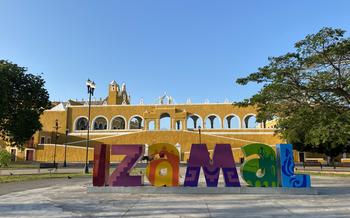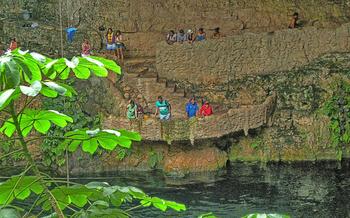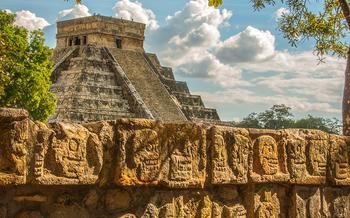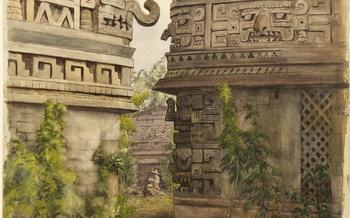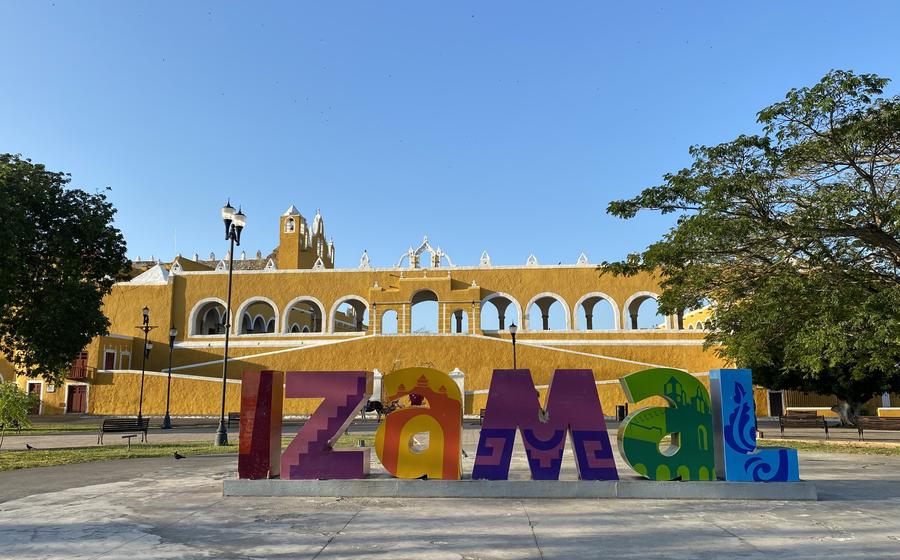
Cenote Xcajum (Nearby city)
- History of Cenote Xcajum:
- Geological Formation
- Natural Beauty
- Photography
- Hiking and Nature Trails
- Flora and Fauna
- Cultural Significance
- Local Cuisine:
- Souvenirs and Handicrafts
- Accommodation
- Accessibility
- Best Time to Visit
- Insider Tip: Unraveling the Cenote's Hidden Treasures
History of Cenote Xcajum:
Cenote Xcajum holds a significant place in Mayan history, dating back to ancient times. The Mayans revered cenotes as sacred portals to the underworld and believed they possessed mystical powers. Cenote Xcajum served as a natural well, providing the local Mayan community with fresh water for drinking and irrigation. Beyond its practical importance, the cenote was a site of spiritual connection and religious rituals. Archaeological discoveries at the site have uncovered offerings and artifacts, offering glimpses into the Mayan culture and their reverence for the cenote. Legends and myths intertwined with the history of Cenote Xcajum, adding to its allure and mystique.
Geological Formation
The Cenote Xcajum is a result of a complex geological process known as karst formation. Over millions of years, rainwater seeping through the porous limestone bedrock dissolved the minerals, creating underground chambers and tunnels. Eventually, the roof of one of these chambers collapsed, forming the cenote we see today.
The cenote's unique geological features add to its allure. The surrounding rock formations, shaped by the erosive forces of water, create a dramatic backdrop for the crystal-clear waters. Stalactites and stalagmites, formed by the deposition of minerals from dripping water, hang from the ceiling and rise from the floor, creating a surreal and enchanting atmosphere.
The cenote's ecosystem is closely intertwined with its geological structure. The water in the cenote is filtered through the limestone, which removes impurities and gives it a pristine clarity. This, coupled with the abundance of sunlight that reaches the cenote, creates an ideal environment for various aquatic plants and animals to thrive, contributing to the cenote's rich biodiversity.
Natural Beauty
The Cenote Xcajum is a sight to behold, with its crystal-clear waters that shimmer in the sunlight. The cenote's walls and ceiling are adorned with vibrant colors, creating a mesmerizing display of natural art. Unique stalactite and stalagmite formations hang from the ceiling, adding to the cenote's otherworldly charm. The surrounding lush vegetation, with its towering trees and exotic plants, further enhances the cenote's natural beauty, creating a tranquil and serene atmosphere that invites visitors to relax and soak in the beauty of nature.
Photography
The Cenote Xcajum offers a breathtaking canvas for photography enthusiasts, whether you're a seasoned professional or simply capturing your travel memories. To do justice to the cenote's beauty, opt for a waterproof camera or an underwater housing for your DSLR. Experiment with different shutter speeds to capture the ethereal movement of the water and the play of light and shadow within the cenote. For stunning underwater shots, adjust your camera settings to compensate for the lack of natural light. The cenote's vibrant colors and unique formations create a natural backdrop for Instagram-worthy shots. Take advantage of the shallow areas where sunlight filters through the water, creating a surreal and magical ambiance. With a bit of patience and creativity, you can capture the essence of this natural wonder and share it with the world.
Hiking and Nature Trails
Nature's Embrace: Exploring the Trails Around Cenote Xcajum
Step into the verdant embrace of nature as you embark on a hiking adventure around Cenote Xcajum. A network of well-maintained trails invites you to discover the diverse flora and fauna that call this enchanting place home. Embrace the tranquility as you wander amidst towering trees and lush undergrowth, each step revealing a new wonder.
The trails vary in length and difficulty, catering to hikers of all levels. Whether you prefer a leisurely stroll or a challenging trek, there's a path that suits your pace. As you delve deeper into the jungle, keep your eyes peeled for exotic birds flitting through the foliage, colorful butterflies fluttering by, and the occasional glimpse of a shy animal scurrying away.
Along the trails, you'll encounter scenic viewpoints that offer breathtaking panoramas of the surrounding landscape. Capture the beauty of the cenote from a unique perspective as you gaze upon its crystal-clear waters and lush vegetation from above. These viewpoints provide the perfect opportunity to rest, soak in the serenity, and capture some Insta-worthy shots.
Remember to wear comfortable hiking attire and sturdy footwear to navigate the trails safely. A hat, sunscreen, and insect repellent are also recommended to ensure a comfortable and enjoyable hike. Embrace the rejuvenating power of nature as you explore the trails around Cenote Xcajum, creating memories that will last a lifetime.
Flora and Fauna
Cenote Xcajum is a haven of biodiversity, showcasing the diverse flora and fauna of the Yucatan Peninsula. The surrounding jungle boasts an array of tropical trees, including mahogany, ceiba, and flamboyant, providing a habitat for a variety of birds, insects, and reptiles. Colorful orchids, bromeliads, and ferns adorn the cenote's walls and crevices, adding to its enchanting beauty.
Among the notable animal species found in the cenote's ecosystem are the Yucatan black howler monkey, whose distinctive calls can be heard echoing through the jungle, and the elegant white-tailed deer, often seen grazing in the surrounding forest. The cenote's waters are home to various fish species, including cichlids, mollies, and guppies, which dart and shimmer in the crystal-clear water.
Conservation efforts are underway to protect the cenote's delicate ecosystem and its diverse flora and fauna. Visitors are encouraged to respect the natural environment and avoid disturbing the wildlife. By doing so, we can ensure that future generations can continue to marvel at the beauty and biodiversity of Cenote Xcajum.
In a memorable encounter, I once spotted a family of howler monkeys swinging through the trees above the cenote. Their playful antics and ear-piercing calls filled the air, creating a truly unforgettable moment. The cenote's ecosystem is truly a testament to the incredible biodiversity of the Yucatan Peninsula.
Cultural Significance
For the ancient Mayans, Cenote Xcajum was more than just a natural wonder; it held profound cultural and spiritual significance. They believed the cenote was a portal to the underworld, a place of communication with the gods. Rituals and ceremonies were performed at the cenote, seeking blessings, rain, and protection. Offerings were made to the gods, including precious objects, food, and even human sacrifices. The cenote was considered a sacred place, and its waters were believed to have healing powers.
Today, the cenote continues to hold cultural importance. Contemporary Maya communities still visit the cenote for spiritual ceremonies and offerings. The cenote is also a popular destination for cultural events and festivals, celebrating the rich traditions of the Yucatan. Visitors can witness traditional Mayan dances, music, and rituals, gaining a glimpse into the enduring cultural heritage of the region.
Local Cuisine:
Indulge in the flavors of Yucatecan cuisine, renowned for its vibrant colors, bold spices, and unique ingredients. Savor the iconic dish, Cochinita Pibil, a slow-roasted pork marinated in achiote paste, wrapped in banana leaves, and cooked underground. Try Panuchos, a crispy tortilla topped with refried beans, shredded turkey, and pickled onions. Don't miss Salbutes, another tortilla delight topped with lettuce, tomato, and avocado, served with a flavorful turkey or chicken stew. For a refreshing treat, try Horchata, a creamy rice-based beverage, or Jamaica, a hibiscus flower drink. Immerse yourself in the local culinary scene and discover the rich flavors that make Yucatan cuisine a must-try for every traveler.
Souvenirs and Handicrafts
Cenote Xcajum is a treasure trove of unique souvenirs and handicrafts that reflect the rich cultural heritage of the region. Local markets and shops line the streets near the cenote, offering a vibrant array of handmade goods. From intricate pottery and woven textiles to colorful paintings and wood carvings, you're sure to find something special to take home as a reminder of your visit.
Local artisans use traditional techniques passed down through generations to create their beautiful products. You'll find hand-embroidered blouses, hammocks, and tablecloths, as well as unique jewelry pieces made from silver, jade, and other semi-precious stones.
Bargaining is a common practice in local markets, so don't be afraid to negotiate a fair price. Your purchases not only support the local economy but also help preserve the traditional crafts of the region.
Insider Tip: Look for the women selling hand-woven hats and bags made from natural fibers. These are not only beautiful but also durable and perfect for a day out exploring the cenote and its surroundings.
Accommodation
When seeking a place to stay near Cenote Xcajum, you'll find a range of options to suit every taste and budget. From cozy guesthouses and hostels catering to backpackers to luxurious hotels offering a pampering experience, there's something for every traveler.
For budget-conscious travelers, hostels and guesthouses offer a comfortable and affordable stay. These establishments often provide shared dormitories or private rooms, allowing you to meet fellow travelers and keep costs down.
If you prefer a more upscale experience, several hotels in the area offer a range of amenities, including swimming pools, restaurants, and spas. These hotels provide a tranquil oasis to relax and unwind after a day of exploring the cenote and its surroundings.
For a truly unique experience, consider staying in one of the nearby eco-lodges. These lodges are designed to minimize environmental impact while offering guests a chance to immerse themselves in the natural beauty of the area.
No matter your budget or preferences, you'll find a range of accommodation options near Cenote Xcajum to ensure a comfortable and enjoyable stay.
Accessibility
Reaching Cenote Xcajum is a breeze, whether you're driving your own car or relying on public transportation. If you're self-driving, simply follow the well-marked roads from any major city or town in the Yucatán Peninsula. There's ample parking space available near the cenote, so you won't have to worry about finding a spot. For those without a car, fear not! Public transportation options are readily available, with regular buses departing from nearby towns and cities. Once you arrive at the cenote, you'll be greeted by a short, easily navigable path that leads you straight to this natural wonder. And for those with disabilities, rest assured that the cenote is wheelchair accessible, ensuring everyone can experience its beauty.
Best Time to Visit
The best time to visit Cenote Xcajum is during the dry season, which runs from November to May. During this time, the weather is generally sunny and pleasant, with minimal rainfall, allowing for ideal swimming and snorkeling conditions. The water is crystal-clear, providing excellent visibility for exploring the cenote's underwater world.
To avoid crowds and enjoy a more serene experience, it is advisable to visit the cenote during the early morning or late afternoon when there are fewer visitors. The cenote is also open for night swimming, offering a unique opportunity to witness the stars reflected in the water, creating a magical and unforgettable experience.
During certain times of the year, the cenote hosts special events and festivals that celebrate Mayan culture and traditions. These events often feature live music, traditional dances, and food stalls, providing visitors with a deeper immersion into the region's rich heritage.
In summary, the best time to visit Cenote Xcajum is during the dry season, early morning or late afternoon, and during special events to fully appreciate its natural beauty and cultural significance.
Insider Tip: Unraveling the Cenote's Hidden Treasures
Beyond the allure of its crystalline waters and captivating formations, Cenote Xcajum conceals hidden gems waiting to be discovered. Off the beaten path, nestled amidst the lush vegetation, lies a secluded chamber adorned with ancient Mayan glyphs and petroglyphs. These enigmatic symbols, etched into the rock walls, offer a glimpse into the spiritual significance of the cenote for the Maya.
Venture further into the cenote's depths, and you may encounter a subterranean passage leading to a hidden chamber. This secret chamber, once used for sacred rituals and ceremonies, exudes an aura of mystery and awe. Its walls adorned with intricate carvings and offerings left by the Maya evoke a sense of reverence and connection to the past.
For those seeking a truly immersive experience, consider embarking on a guided night tour of the cenote. As darkness envelops the surroundings, the cenote transforms into a mystical realm illuminated by flickering torches. The eerie silence is broken only by the gentle sound of dripping water and the echo of your footsteps. This unique nocturnal adventure offers a glimpse into the cenote's hidden depths and unveils its nocturnal secrets.
Whether you seek a secluded spot for contemplation, a glimpse into ancient Mayan culture, or an adrenaline-fueled night exploration, Cenote Xcajum offers hidden treasures that will leave you spellbound. Embrace the spirit of adventure and uncover the secrets that lie beneath the surface of this extraordinary cenote.

